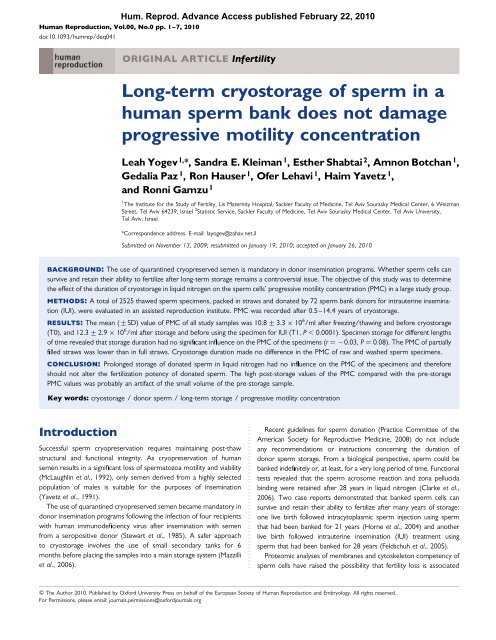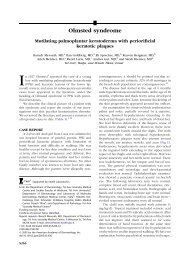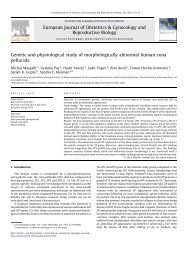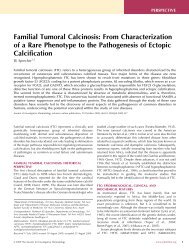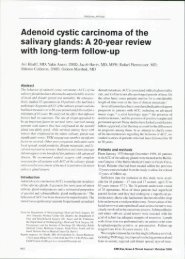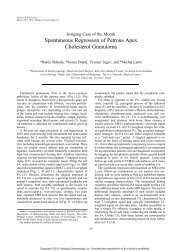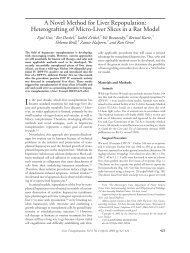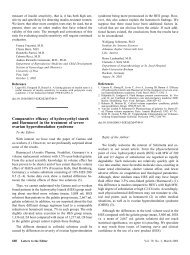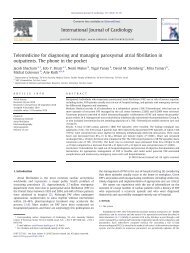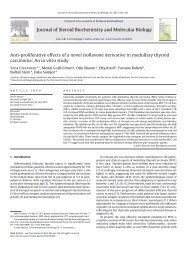Long-term cryostorage of sperm in a human sperm bank does not ...
Long-term cryostorage of sperm in a human sperm bank does not ...
Long-term cryostorage of sperm in a human sperm bank does not ...
Create successful ePaper yourself
Turn your PDF publications into a flip-book with our unique Google optimized e-Paper software.
4 Yogev et al.Table II Effect and distribution <strong>of</strong> storage length on PMC (mean + SD) and median (<strong>in</strong> parentheses) <strong>of</strong> specimenscryopreserved for women future treatments (n 5 1239).Storage (years) Subgroup size (% <strong>of</strong> total group) T0 PMC and (median) T1 PMC and (median) D(T12T0).............................................................................................................................................................................................0.5–3 127 (10) 11.6 + 4.60 (11.0) 12.1 + 5.58 (11.0) 0.5 + 4.80.3–5 458 (37) 10.6 + 3.70 (10.0) 12.0 + 4.21 (11.0) 1.5 + 4.56.5–7 287 (23) 10.1 + 5.04 (9.0) 11.9 + 4.14 (11.0) 1.8 + 4.54.7–10 293 (24) 10.6 + 4.18 (10.0) 11.8 + 4.05 (11.0) 1.3 + 4.40.10 74 (6) 11.7 + 7.87 (9.0) 12.1 + 4.17 (12.0) 0.4 + 6.08PMC, progressive motility concentration (10 6 /ml), T0, value <strong>of</strong> sample after freez<strong>in</strong>g/thaw<strong>in</strong>g and before storage, T1, value after storage and thaw<strong>in</strong>g before <strong>in</strong>sem<strong>in</strong>ation. There aresignificant differences between the five subgroups for T0 (P ¼ 0.009) and for D(T12T0) (P ¼ 0.041), while there is no significant difference for T1 (P ¼ 0.96).Table III Progressive motility concentration (10 6 /ml) <strong>in</strong> the same 19 donors after short-<strong>term</strong> and long-<strong>term</strong> storage.# Donor Short-<strong>term</strong> storage......................................................<strong>Long</strong>-<strong>term</strong> storage....................................................P-valueNo. <strong>of</strong> straws PMC No. <strong>of</strong> straws PMC.............................................................................................................................................................................................1 65 13.5 + 6.8 27 12.3 + 3.1 0.2542 61 9.3 + 4.3 14 10.9 + 3.1 0.1963 52 10.8 + 4.3 56 10.3 + 3.1 0.4664 61 11.4 + 3.9 45 13.3 + 4.8 0.0275 61 10.3 + 3.3 17 9.9 + 2.6 0.7176 64 11.5 + 3.8 31 13.0 + 6.5 0.2537 62 10.0 + 2.93 15 11.6 + 2.1 0.0488 87 13.2 + 8.7 14 9.9 + 2.3 0.0059 75 11.5 + 4.1 13 11.8 + 5.3 0.85210 67 11.3 + 5.0 12 13.3 + 2.4 0.03311 67 14.4 + 5.5 2 20.5 + 6.4 0.12912 65 10.8 + 3.0 41 12.6 + 3.6 0.00813 63 12.3 + 4.4 29 8.8 + 1.4 ,0.00114 66 14.3 + 4.8 15 13.9 + 2.9 0.66615 60 12.8 + 3.6 12 12.3 + 3.4 0.70116 63 13.7 + 5.7 6 11.3 + 1.6 0.02417 61 10.4 + 2.5 16 10.4 3.3 0.99518 64 8.7 + 2.1 24 9.7 + 3.6 0.18719 122 12.2 + 4.0 20 11.8 + 2.1 0.704Values are mean + SD. There was no difference with<strong>in</strong> the same <strong>in</strong>dividual donor (P . 0.05) for most <strong>of</strong> them.Effect <strong>of</strong> storage length on <strong>in</strong>dividual donorsTest<strong>in</strong>g the possible <strong>in</strong>fluence <strong>of</strong> length <strong>in</strong> <strong>cryostorage</strong> on <strong>in</strong>dividualdonors revealed a significant <strong>in</strong>fluence <strong>in</strong> 11 <strong>of</strong> 72 donors, but the f<strong>in</strong>d<strong>in</strong>gswere <strong>not</strong> uniform; four <strong>sperm</strong> donors had a negative Pearson correlation(a damage effect), whereas the rema<strong>in</strong><strong>in</strong>g seven showed apositive one. The <strong>in</strong>fluence <strong>of</strong> length <strong>of</strong> time <strong>in</strong> <strong>cryostorage</strong> on thePMC <strong>in</strong> 20 <strong>in</strong>dividual <strong>sperm</strong> donors who contributed a relativelylarge number <strong>of</strong> specimens (more than 50 each) is shown <strong>in</strong>Table IV. Only two <strong>of</strong> them showed a significant storage <strong>in</strong>fluence(Nos. 8 and 13), and both showed a positive correlation, i.e. thelength <strong>of</strong> time <strong>in</strong> <strong>cryostorage</strong> ‘<strong>in</strong>creased’ the specimen quality.Similar results were also shown when several aliquots (at leastthree) from the same ejaculate were thawed after different lengths<strong>of</strong> time <strong>in</strong> storage (n ¼ 483 aliquots, r ¼ 20.04, P ¼ 0.27, Fig. 1).An <strong>in</strong>fluence <strong>of</strong> the storage length on D(T12T0) could <strong>not</strong> bedemonstrated.Comparison between raw and washed <strong>sperm</strong>specimens storageTo evaluate whether raw specimens (cryopreserved with sem<strong>in</strong>alfluid) can survive <strong>cryostorage</strong> differently to washed <strong>sperm</strong> samples(i.e. after sem<strong>in</strong>al fluid has been replaced by a <strong>human</strong> tubal fluidmedium), specimens were divided <strong>in</strong>to two groups by type <strong>of</strong>sample preparation before <strong>cryostorage</strong>. Raw specimens were mixedwith the freez<strong>in</strong>g medium <strong>in</strong> Group A (n ¼ 1157) and the specimenswere washed before <strong>cryostorage</strong> <strong>in</strong> Group B (n ¼ 1365). The mean
<strong>Long</strong>-<strong>term</strong> <strong>cryostorage</strong> <strong>in</strong> <strong>human</strong> <strong>sperm</strong> <strong>bank</strong><strong>in</strong>g 5Table IV The <strong>in</strong>fluence <strong>of</strong> storage length (mean + SD) on PMC (mean + SD) <strong>of</strong> <strong>in</strong>dividual donors (n 5 20) whocontributed more than 50 specimens each.#Donor Specimens (n) Storage length (years) T0 PMC (10 6 /ml) T1 PMC (10 6 /ml) P-value r.............................................................................................................................................................................................1 92 3.50 + 4.36 12.90 + 5.20 13.10 + 5.94 0.39 20.092 75 2.70 + 3.06 8.70 + 2.59 9.64 + 4.11 0.30 0.123 108 4.20 + 3.62 9.46 + 3.80 10.54 + 3.72 0.56 0.064 53 7.25 + 3.09 7.13 + 3.33 9.19 + 2.82 0.35 20.135 106 3.10 + 2.82 9.87 + 4.34 12.24 + 4.37 0.83 0.026 78 2.14 + 2.32 10.36 + 4.70 10.18 + 3.12 0.73 20.047 95 2.94 + 2.06 12.00 + 6.12 11.99 + 4.8 0.24 0.128 77 3.00 + 3.36 8.70 + 2.54 10.30 + 2.85 0.04 0.239 101 1.60 + 0.77 11.16 + 6.55 12.74 + 8.20 0.22 20.1210 88 1.70 + 0.82 9.44 + 3.83 11.56 + 4.29 0.53 20.0711 79 2.15 + 1.88 10.20 + 4.21 11.58 + 4.76 0.25 0.1312 69 1.72 + 1.49 11.90 + 3.19 14.58 + 5.58 0.25 0.1413 106 3.35 + 2.28 9.36 + 2.35 11.53 + 3.34 0.05 0.1914 92 2.61 + 1.92 9.60 + 3.11 11.17 + 4.02 0.06 20.2015 81 2.51 + 1.56 10.70 + 2.41 14.27 + 4.47 0.62 20.0616 72 2.42 + 1.38 10.36 + 2.99 12.69 + 3.53 0.35 20.1117 69 1.78 + 1.26 11.70 + 4.37 13.52 + 5.55 0.37 20.1118 77 2.30 + 1.96 8.80 + 1.81 10.40 + 2.66 0.89 0.0219 88 3.11 + 2.98 8.60 + 2.83 8.90 + 2.63 0.15 0.1520 142 2.50 + 1.78 10.34 + 2.26 11.90 + 3.79 0.86 0.01Nos. 8 and 13 had a significant storage <strong>in</strong>fluence, both with a positive correlation. PMC, progressive motility concentration, T0, value <strong>of</strong> sample after freez<strong>in</strong>g/thaw<strong>in</strong>g and before storage,T1, value after storage and thaw<strong>in</strong>g before <strong>in</strong>sem<strong>in</strong>ation.storage lengths <strong>of</strong> the two groups were 4.2 + 0.09 and 3.2 + 0.05years, respectively. The mean change <strong>in</strong> PMC, between the thawedsamples that were used for treatment (T1) and those that werethawed immediately after freez<strong>in</strong>g and before cryopreserv<strong>in</strong>g (T0),was similar (1.56 + 0.12 and 1.38 + 0.13 10 6 /ml, respectively).Observation <strong>of</strong> the PMC after storage revealed that the length <strong>of</strong>time <strong>in</strong> <strong>cryostorage</strong> did <strong>not</strong> <strong>in</strong>fluence the PMC values <strong>in</strong> eitherGroup A or Group B (r ¼ 0.02, P ¼ 0.48 and r ¼ 0.042, P ¼ 0.12,respectively).DiscussionThis evaluation <strong>of</strong> the largest ever-reported number <strong>of</strong> cryopreserved<strong>sperm</strong> <strong>bank</strong> donor specimens revealed that up to 14 years <strong>in</strong>storage caused no demonstrable decrease <strong>in</strong> progressive motility.This f<strong>in</strong>d<strong>in</strong>g is very encourag<strong>in</strong>g, because progressive motility percentagesand concentrations are reportedly the best prognostic parametersfor pregnancy <strong>in</strong> IUI with donor semen (Larsen et al., 2000;Freour et al., 2009). Moreover, <strong>sperm</strong> motility after thaw<strong>in</strong>g providesthe most significant parameter for predict<strong>in</strong>g donor <strong>sperm</strong> fertilitypotential (Marshburn et al., 1992).Whatever procedure <strong>of</strong> freez<strong>in</strong>g is used, <strong>sperm</strong> cells are damagedby undergo<strong>in</strong>g either structural or functional changes or both(O’Connell et al., 2002; Thomson et al., 2009). Damage to <strong>human</strong><strong>sperm</strong>atozoa can be recognized immediately after freez<strong>in</strong>g–thaw<strong>in</strong>gas a loss <strong>in</strong> motility, but there is a possibility that further harmcan be caused to the <strong>sperm</strong> cells dur<strong>in</strong>g storage (Desrosier et al.,2006).Sperm frozen <strong>in</strong> sem<strong>in</strong>al fluid has appeared to be more resistant todamage associated with freez<strong>in</strong>g than washed <strong>sperm</strong> (Donnelly et al.,2001; Saritha and Bongso, 2001). When we assessed the <strong>in</strong>fluence <strong>of</strong>the length <strong>of</strong> time <strong>in</strong> <strong>cryostorage</strong> on the PMC <strong>of</strong> specimens cryopreservedwith and without sem<strong>in</strong>al plasma, however, we found no differencebetween the two groups.Unexpectedly, there was a significant difference <strong>in</strong> PMC afterfreez<strong>in</strong>g process survival <strong>of</strong> samples between partially filled andtotally filled straws. Consequently, <strong>in</strong>stead <strong>of</strong> show<strong>in</strong>g zero value <strong>of</strong>D(T12T0) because <strong>of</strong> the absence <strong>of</strong> storage <strong>in</strong>fluence, an <strong>in</strong>crease<strong>in</strong> PMC that was <strong>not</strong> <strong>in</strong>fluenced by the storage length could bedemonstrated. In order to establish the quality <strong>of</strong> each freez<strong>in</strong>g(before storage), we therefore recommend us<strong>in</strong>g a full straw thathas a small volume (e.g. 0.25 ml) for sav<strong>in</strong>g the valuable specimen,<strong>in</strong>stead <strong>of</strong> partially fill<strong>in</strong>g a 0.5-ml straw. Still, the change <strong>in</strong> PMCmay be due to ‘technical’ artifacts rather than to a biologicaleffect. A recent study demonstrated that with a decrease <strong>in</strong>volume, and therefore an <strong>in</strong>crease <strong>in</strong> surface area-to-volume ratio,the <strong>in</strong>tra-conta<strong>in</strong>er pressure dur<strong>in</strong>g freez<strong>in</strong>g <strong>in</strong>creases and causesmore cryodamage to the cells than <strong>does</strong> large volume freez<strong>in</strong>g (Saragustyet al., 2009). Further studies are required to identify thefactor(s) responsible for the decl<strong>in</strong>e <strong>in</strong> PMC <strong>in</strong> a partially filledstraw, such as free radicals that may be produced dur<strong>in</strong>g the freez<strong>in</strong>gprocess or the effect <strong>of</strong> high pressure <strong>in</strong> a small aliquot.
6 Yogev et al.Figure 1 Progressive motility concentration (PMC) values <strong>in</strong> ejaculates <strong>of</strong> n<strong>in</strong>e donors (A–I). Each draw<strong>in</strong>g represents a PMC <strong>of</strong> at least threealiquots from a s<strong>in</strong>gle specimen that was thawed after different lengths <strong>of</strong> storage time (T1). The value <strong>of</strong> PMCs <strong>of</strong> thawed samples beforestorage (T0) is shown as a horizontal l<strong>in</strong>e. (E) Three different ejaculates <strong>of</strong> the same donor are shown by three <strong>in</strong>dexes (empty circle, filled-<strong>in</strong>circle and square). A significant <strong>in</strong>fluence <strong>of</strong> the lengths <strong>of</strong> <strong>cryostorage</strong> time on D(T12T0) could <strong>not</strong> be demonstrated.There were vary<strong>in</strong>g degrees <strong>of</strong> <strong>in</strong>fluence <strong>of</strong> length <strong>of</strong> time <strong>in</strong> <strong>cryostorage</strong>on <strong>in</strong>dividual donors. There was a decrease <strong>of</strong> PMC <strong>in</strong> someand an <strong>in</strong>crease <strong>in</strong> others. Interest<strong>in</strong>gly, three ejaculates <strong>of</strong> the samedonor (Fig. 1E) showed greater, less and no <strong>in</strong>fluence <strong>of</strong> the length<strong>of</strong> time they were <strong>in</strong> <strong>cryostorage</strong>. These results support the positionthat there is no remarkable and last<strong>in</strong>g change <strong>in</strong> PMC after long-<strong>term</strong><strong>cryostorage</strong>.In a previous report from our <strong>sperm</strong> <strong>bank</strong>, an overall pregnancy rate<strong>of</strong> 12.1% was achieved with frozen–thawed <strong>sperm</strong>atozoa (Botchanet al., 2001). A comparison between the fertility rate <strong>of</strong> the cryopreservedsemen after short- and long-<strong>term</strong> storage would obviously contributeto the significance <strong>of</strong> the present study. However, the olderage <strong>of</strong> the women <strong>in</strong> the present study taken together with theextended storage time can be expected to dramatically reduce thevalue <strong>of</strong> such a comparison.We concluded that the length <strong>of</strong> time dur<strong>in</strong>g which <strong>sperm</strong> is stored<strong>in</strong> liquid nitrogen has no <strong>in</strong>jurious effect on PMC and consequently, onthe fertiliz<strong>in</strong>g potency <strong>of</strong> donated <strong>sperm</strong>. When the effect <strong>of</strong> freez<strong>in</strong>g isexam<strong>in</strong>ed by the thaw<strong>in</strong>g <strong>of</strong> a small sample volume <strong>in</strong> partially filledstraws, it should be borne <strong>in</strong> m<strong>in</strong>d that the PMC will be lower <strong>in</strong>the sample than <strong>in</strong> the rest <strong>of</strong> the stored specimen.Authors’ rolesL.Y.: conception and design, collection, assembly <strong>of</strong> data and writ<strong>in</strong>gthe manuscript. S.E.K.: critical revision <strong>of</strong> the manuscript. E.S.: analyz<strong>in</strong>gthe data and perform<strong>in</strong>g the statistical evaluation. A.B.: revision<strong>of</strong> the manuscript. G.P.: contribution to the conception <strong>of</strong>the model; revision <strong>of</strong> the manuscript. R.H.: critical revision <strong>of</strong>the manuscript; approval <strong>of</strong> the f<strong>in</strong>al version. O.L.: design andcoord<strong>in</strong>ation <strong>of</strong> the research. H.Y.: conception and design <strong>of</strong> theresearch, correction <strong>of</strong> the manuscript. R.G.: concept and design<strong>of</strong> the research, data <strong>in</strong>terpretation and critical revision <strong>of</strong> themanuscript.AcknowledgementThe authors thank the laboratory technicians <strong>of</strong> The Institute for theStudy <strong>of</strong> Fertility for skillful and excellent technical work, Ms EstherEshkol, Tel Aviv Medical Center, for expert editorial assistance andMs Sigalit Siso <strong>of</strong> The Graphics Unit, Tel Aviv Medical Center, forthe skilled graphic illustration.
<strong>Long</strong>-<strong>term</strong> <strong>cryostorage</strong> <strong>in</strong> <strong>human</strong> <strong>sperm</strong> <strong>bank</strong><strong>in</strong>g 7Fund<strong>in</strong>gThe study was carried out under the auspices <strong>of</strong> the Alan and AdaSelwyn Chair <strong>in</strong> Cl<strong>in</strong>ical Infertility Research and Molecular Medic<strong>in</strong>e(Melbourne, Australia) (grant recipient, G.P.).ReferencesBotchan A, Hauser R, Gamzu R, Yogev L, Paz G, Yavetz H. Results <strong>of</strong> 6139artificial <strong>in</strong>sem<strong>in</strong>ation cycles with donor <strong>sperm</strong>atozoa. Hum Reprod2001;16:2298–2304.Clarke GN, Liu DY, Baker HWG. Recovery <strong>of</strong> <strong>human</strong> <strong>sperm</strong> motility andability to <strong>in</strong>teract with the <strong>human</strong> zona pellucida after more than 28years <strong>of</strong> storage <strong>in</strong> liquid nitrogen. Fertil Steril 2006;86:721–722.Desrosier P, Légaré C, Leclerc P, Sullivan R. Membranous and structuraldamage that occur dur<strong>in</strong>g cryopreservation <strong>of</strong> <strong>human</strong> <strong>sperm</strong> may betime-related events. Fertil Steril 2006;85:1744–1752.Donnelly ET, McClure N, Lewis SEM. Cryopreservation <strong>of</strong> <strong>human</strong> semenand prepared <strong>sperm</strong>: effects on motility parameters and DNA <strong>in</strong>tegrity.Fertil Steril 2001;76:892–900.Edelste<strong>in</strong> A, Yavetz H, Kleiman SE, Hauser R, Amnon B, Paz G, Yogev L.Effect <strong>of</strong> long-<strong>term</strong> storage on deoxyribonucleic acid damage andmotility <strong>of</strong> <strong>sperm</strong> <strong>bank</strong> donor specimens. Fertil Steril 2008;90:1327–1330.Feldschuh J, Brassel J, Durso N, Lev<strong>in</strong>e A. Successful <strong>sperm</strong> storage for 28years. Fertil Steril 2005;84:1017.Freour T, Jean M, Mirallia S, Langlois ML, Dubourdieu S, Barriere P.Predictive value <strong>of</strong> CASA parameters <strong>in</strong> IUI with frozen donor <strong>sperm</strong>.Int J Androl 2009;32:498–504.Horne G, Atk<strong>in</strong>son AD, Pease EH, Logue JP, Brison DR, Lieberman BA.Live birth with <strong>sperm</strong> cryopreserved for 21 years prior to cancertreatment: case report. Hum Reprod 2004;19:1448–1449.Larsen L, Scheike T, Jensen TK, Bonde JP, Ernst E, Hjollund NH, Zhou Y,Skakkebaek NE, Giwercman A. Computer-assisted semen analysisparameters as predictors for fertility <strong>of</strong> men from the generalpopulation. The Danish First Pregnancy Planner Study Team. HumReprod 2000;15:1562–1567.Marshburn PB, McIntire D, Carr BR, Byrd W. Spermatozoal characteristicsfrom fresh and frozen donor semen and their correlation with fertilityoutcome after <strong>in</strong>trauter<strong>in</strong>e <strong>in</strong>sem<strong>in</strong>ation. Fertil Steril 1992;58:179–186.Mazzilli F, Delf<strong>in</strong>o M, Imbrogno N, Elia, Dondero F. Survival <strong>of</strong>micro-organisms <strong>in</strong> <strong>cryostorage</strong> <strong>of</strong> <strong>human</strong> <strong>sperm</strong>. Cell Tissue Bank2006;7:75–79.McLaughl<strong>in</strong> EA, Ford WC, Hull MG. Motility characteristics and membrane<strong>in</strong>tegrity <strong>of</strong> cryopreserved <strong>human</strong> <strong>sperm</strong>atozoa. J Reprod Fertil 1992;95:527–534.Menkveld R, Kruger TF. Advantages <strong>of</strong> strict (Tygerberg) criteria forevaluation <strong>of</strong> <strong>sperm</strong> morphology. Int J Androl 1995;18 (Suppl 2):36–42.O’Connell M, McClure N, Lewis SE. The effects <strong>of</strong> cryopreservation on<strong>sperm</strong> morphology, motility, and mitochondrial function. Hum Reprod2002;17:704–709.Practice Committee <strong>of</strong> the American Society for Reproductive Medic<strong>in</strong>e,and the Practice Committee <strong>of</strong> the Society for Assisted ReproductiveTechnology. 2008 Guidel<strong>in</strong>es for gamete and embryo donation: aPractice Committee report. Fertil Steril 2008;90 (Suppl):S30–S44.Saragusty J, Gacitua H, Rozenboim I, Arav A. Do physical forces contributeto cryodamage? Biotechnol Bioeng 2009;104:719–728.Saritha KR, Bongso A. Comparative evaluation <strong>of</strong> fresh and washed <strong>human</strong><strong>sperm</strong> cryopreserved <strong>in</strong> vapor and liquid phases <strong>of</strong> liquid. J Androl 2001;22:857–862.Stewart GJ, Tyler JP, Cunn<strong>in</strong>gham AL, Barr JA, Driscoll GL, Gold J,Lamont BJ. Transmission <strong>of</strong> <strong>human</strong> T-cell lymphotropic virus type III(HTLV-III) by artificial <strong>in</strong>sem<strong>in</strong>ation by donor. Lancet 1985;2:581–585.Thomson LK, Flem<strong>in</strong>g SD, Aitken RJ, De Iuliis GN, Zieschang JA,Clark AM. Cryopreservation-<strong>in</strong>duced <strong>human</strong> <strong>sperm</strong> DNA damage ispredom<strong>in</strong>antly mediated by oxidative stress rather than apoptosis.Hum Reprod 2009;24:2061–2070.WHO. WHO Laboratory Manual for the Exam<strong>in</strong>ation <strong>of</strong> Human Semen andSperm-Cervical Mucus Interaction. Cambridge: Cambridge UniversityPress, 1999. UK.Yavetz H, Yogev L, Hommonai Z, Paz G. Prerequisites for successful<strong>human</strong> <strong>sperm</strong> cryo<strong>bank</strong><strong>in</strong>g: <strong>sperm</strong> quality and prefreez<strong>in</strong>g hold<strong>in</strong>gtime. Fertil Steril 1991;55:812–816.Yogev L, Kleiman S, Shabtai E, Botchan A, Gamzu R, Paz G, Yavetz H,Hauser R. Seasonal variations <strong>in</strong> pre- and post-thaw donor <strong>sperm</strong>quality. Hum Reprod 2004;19:880–885.


